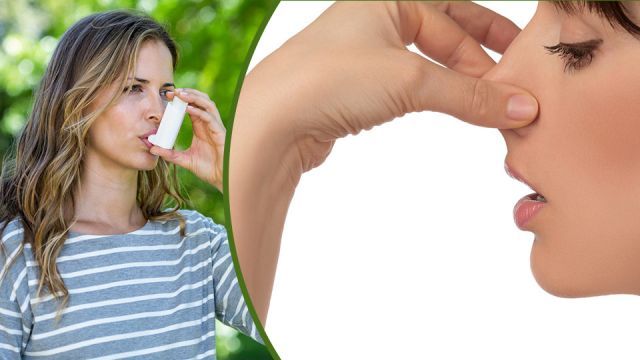
Millions of people in the United States, and across the world, have asthma. This condition, defined broadly as inflammation of the airways, can greatly affect day-to-day life, especially in avenues that involve physical activity. Many asthmatics cannot go anywhere without their inhalers and emergency rescue medications in tow.
While these medications are necessary in certain cases, it is possible that some asthma sufferers could reduce or even stop their use of inhalers by simply changing how they breathe. One method that has shown great promise for asthmatics is the Buteyko breathing method.
First, a little bit about asthma and inhaled steroid use.
The problem with steroid inhalers
To control their asthma, many people use corticosteroid inhalers on a regular or semi-regular basis. While these inhalers work to reduce inflammation in the airways and allow breathing to go back to normal, they do have their side effects. A few of the side effects of long-term and high-dose inhaled steroid use include:
- Sore throat
- Hoarseness
- Thrush
- Decreased bone thickness
- Cataracts
- Glaucoma
While inhaled steroids can be life-saving, and no one who uses them should stop without first consulting a doctor that they trust, it is worth it to look into the Buteyko breathing method to see if it helps your symptoms. Many people have reduced their dependence on inhalers through this method (examples of supporting research later in this article).
What is Buteyko breathing?
The Buteyko breathing method gets its name from its founder, Dr. Konstantin Buteyko. The philosophy of the method is that by correcting how we breathe, we can improve or even remedy many health problems, including asthma. There are no bells and whistles with this method, simply instruction on breathing techniques that, with practice, can help you to breathe more efficiently and without trouble.
The method centers around correcting improper breathing such as mouth breathing, and breathing too heavily. This is done by breathing through the nose, and sometimes by holding one’s breath at certain intervals. According to Patrick McKeown, who was qualified by Dr. Buteyko:
“If you were to look at the basic premise of breathing, we should not hear our breathing during rest. We should see very little movement from the chest and tummy. Ideally, most of our breathing is diaphragmatic, but we shouldn’t see it. The mouth should be closed, breathing should be regular, and breathing should be effortless.”
On Buteyko breathing and asthma, McKeown adds:
“If you’re breathing too heavily, you lose carbon dioxide, and smooth muscles surrounding your airways constrict. Another factor from an asthmatic point of view is dehydration of the inner walls of the airways. It’s a combination of these factors that cause the airways to constrict. Heavy breathing is causing the loss of carbon dioxide. And carbon dioxide also helps to relax smooth muscles surrounding your blood vessels. So, it’s not just the airways which constrict when you’re breathing too much, but it’s also the blood vessels.”
The research on Buteyko Breathing and asthma
For a 2003 study published in the New Zealand Medical Journal, researchers assessed the effectiveness of the Buteyko Breathing Technique (BBT) on 38 patients with asthma. After the six-month study, researchers found that individuals who practiced Buteyko breathing reduced their use of steroid inhalers by 50 percent, and their use of beta-agonist medications by 85 percent.
On the results of this study, the authors wrote, “BBT is a safe and efficacious asthma management technique. BBT has clinical and potential pharmaco-economic benefits that merit further study.”
A 2008 study published in the journal Respiratory Medicine tested the effects of Buteyko breathing versus breathing techniques taught by a physiotherapist on asthma patients who used inhaled corticosteroids. Researchers found that the group that was assigned to Buteyko breathing “significantly reduced” their use of inhaled corticosteroids after the six-month study.
On their results, the authors wrote:
“Six months after completion of the interventions, a large majority of subjects in each group displayed control of their asthma with the additional benefit of reduction in inhaled corticosteroid use in the Buteyko group. The Buteyko technique, an established and widely recognized intervention, or an intensive programme delivered by a chest physiotherapist appear to provide additional benefit for adult patients with asthma who are being treated with inhaled corticosteroid.”
As the premise for another study, published in 2009 in the Journal of Asthma, the authors explained:
“The Buteyko Breathing Technique (BBT) is promoted as a drug-free asthma therapy. It is based on the premise that raising blood PaCO2 through hypoventilation can treat asthma. Our study was designed to examine whether the Buteyko Breathing Technique, as taught by a video, is an efficacious asthma therapy.”
For their study, the researchers divided 36 adults with mild to moderate asthma into two groups. One group received instructional videos in BBT to watch twice each day for four weeks. The control group watched a placebo video. On the results of the study, the authors concluded:
“Our results demonstrated a significant improvement in quality of life among those assigned to the BBT compared with placebo… as well as a significant reduction in inhaled bronchodilator intake… We conclude that the BBT may be effective in improving the quality of life and reducing the intake of inhaled reliever medication in patients with asthma.”
More health benefits of Buteyko breathing
There are many other potential benefits to practicing Buteyko breathing, including a reduction in:
- Mouth breathing
- Snoring
- Poor quality sleep
- Sleep apnea
- Fatigue
- Anxiety
- Panic attacks
- Mood disorders
If you or your loved ones suffer from asthma, or any of the health problems on this list, it’s worth it to do some research on Buteyko breathing — it may help a lot!
— Tanya Mead

